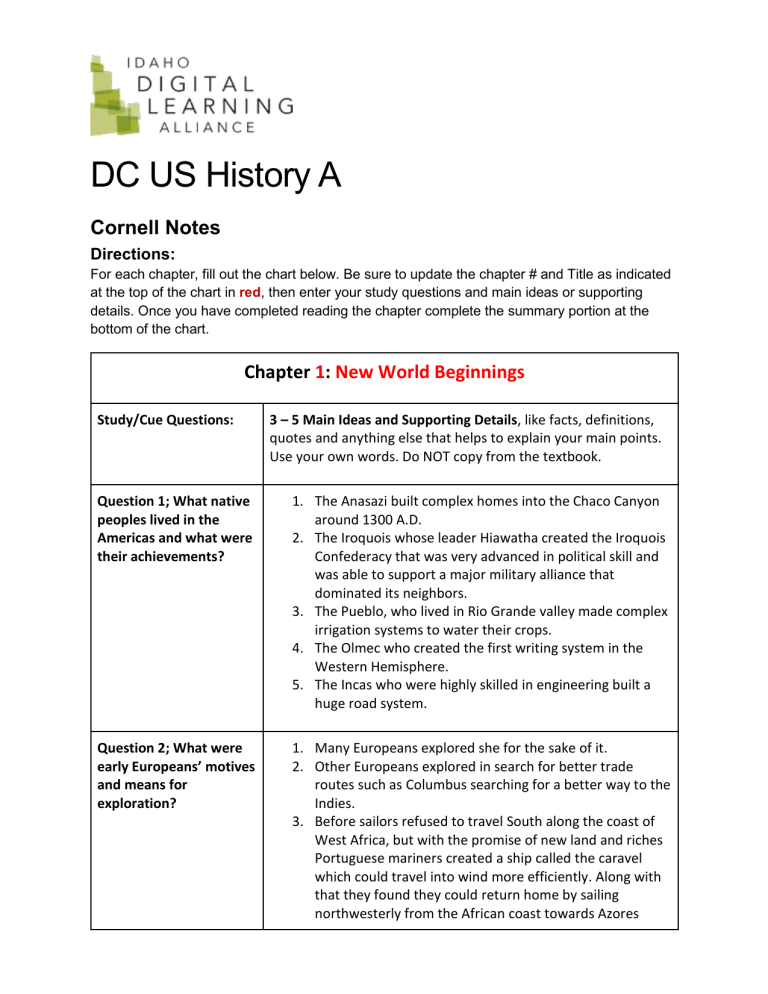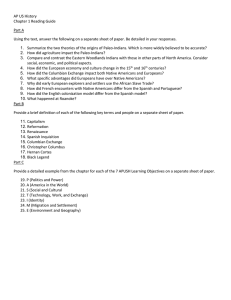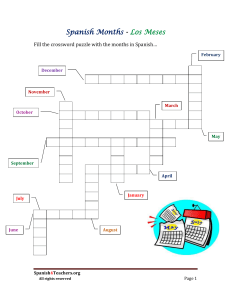
DC US History A Cornell Notes Directions: For each chapter, fill out the chart below. Be sure to update the chapter # and Title as indicated at the top of the chart in red, then enter your study questions and main ideas or supporting details. Once you have completed reading the chapter complete the summary portion at the bottom of the chart. Chapter 1: New World Beginnings Study/Cue Questions: 3 – 5 Main Ideas and Supporting Details, like facts, definitions, quotes and anything else that helps to explain your main points. Use your own words. Do NOT copy from the textbook. Question 1; What native peoples lived in the Americas and what were their achievements? 1. The Anasazi built complex homes into the Chaco Canyon around 1300 A.D. 2. The Iroquois whose leader Hiawatha created the Iroquois Confederacy that was very advanced in political skill and was able to support a major military alliance that dominated its neighbors. 3. The Pueblo, who lived in Rio Grande valley made complex irrigation systems to water their crops. 4. The Olmec who created the first writing system in the Western Hemisphere. 5. The Incas who were highly skilled in engineering built a huge road system. Question 2; What were early Europeans’ motives and means for exploration? 1. Many Europeans explored she for the sake of it. 2. Other Europeans explored in search for better trade routes such as Columbus searching for a better way to the Indies. 3. Before sailors refused to travel South along the coast of West Africa, but with the promise of new land and riches Portuguese mariners created a ship called the caravel which could travel into wind more efficiently. Along with that they found they could return home by sailing northwesterly from the African coast towards Azores where wind would help carry them back home instead of having to fight the wind like previously. Question 3; How did the slave trade originate? 1. Arabs had a system of slavery for those who were in dept. 2. Africans had also been selling slaves for centuries, but these slaves were mostly war prisoners 3. As the Portuguese came in, they set up trade along the coast. Their use of slaves was for their sugar plantations on the African coastal islands. Summary: The chapter begins with how North American was shaped. They explained that the earth was once one continent and that over time it separated into parts creating Eurasia, Africa, Australia, Antarctica, and the Americans. Land masses and water masses continued to shift over time creating different landscapes from mountain ranges to valleys. Secondly, the book speaks about how the Americas became populated. About 35,000 years ago, during the ice age, most of the worlds water was froze in glaciers this helped to expose more land including a stretch between Eurasia and North America. They believe that people during this time fowled herds of game into North America, but as the glaciers melted this land bridge was erased. Over time North America was populated with upwards to 54 million people before the Europeans came. Thirdly, the book goes on to describe the people that inhabited the Americas. They explain that agriculture, mainly corn, was one of the main reasons for the size and sophistication of the Native Americans in Mexico and South America. They go on to talk about the different tribes and their achievements as described in question one, but also how most native people lived in “small scattered, and impermanent settlements”. Fourthly, they discuss how some explores accidently discovered the new world. They discuss how Norse seafarers accidently came upon the northeaster shoulder of North America. Another discover of the new world were the Christian crusaders who during their crusades developed a taste for Asian goods such as silk, spices, perfumes, and pain drugs. Fifthly, the book discusses how Europeans came to enter Africa. After Marco Polo may or may not have went to China his stories of luxury and riches pushed Europeans to explore. This push brought forth the creation of the caravel and new winds as described in question two. The sub-Saharan Africa was now available to the Europeans although they did not have direct access until Portuguese navigators. The book goes on to explain how the Portuguese set up ports along the shore for the purchase of gold and slaves, and how Arabs and Africans had been trading slave for centuries. The Portuguese adopted this and used slaves for their sugar plantations. Sixthly, the book discuss how Columbus discovered the New World and the Consequences of that discovery. Christopher Columbus was outfitted with three small ships and men by the Spanish Monarchs, and on October 12, 1492 they came upon an island in the Bahamas. On this adventure Columbus was search for a new water route to the Indies and when he hit a land barrier, he had assumed in was the indies thus naming the people Indians. As more Europeans go to this new world they are amazed at the differences like rattlesnakes and the different agriculture such as beans and potatoes. Many of these crops were spread through trade and became a major source of food for those who had not had access to it previously. The Europeans introduced to this new world crops and animals from the old world such as horse and cattle. The Europeans also brought disease such as smallpox or yellow fever and as many as 90% of the Native people died due to these diseases. Seventhly, the book goes on to talk about the Spanish Conquistadores. In the Treaty of Tordesillas Spain and Portugal split the “heathen lands” of the new world. While most of the land went to Spain Portugal was compensated with territory in Africa and Asia. Spain then became the main exploring and colonizing power in the 1500s. Some explores that stand out are Vasco Nuñez Balboa who discovered the Pacific Ocean, Ferdinand Magellan’s crew completed the first circumnavigation of the globe, Juan Ponce De León who explored Florida which he thought to be an island, Francisco Coronado discovered the Grand Canyon and the Colorado river, and Hernando De Soto discovered and crossed the Mississippi River. In 1532 Francisco Pizarro defeated the Incas and added much to the Spanish coffers, and by 1600 Spain had a lot of the New Worlds silver which increased consumer cost by 500%. Spanish Invaders of the mainland Americas used the West Indies as a base. Additionally, many of these explorers and many more other men had signed contracts with the Spanish Monarchy to (with money from investors) to recruit armies to gain new land and riches for the Spanish crown. The motives of these men were to gain God’s favor, escape their past, have an adventure, or to earn titles of nobility. While many did not achieve their goals or were even paid very well, the conquistadores were allowed three Indian wives which began a “new race” and formed a cultural bridge between Latin America’s European and the Indian races. Second to last, the describes the conquest of Mexico. In 1519 Hernan Cortez traveled towards Mexico picking up two translators. Near present day Vera Cruz Cotes discovered the wealth and unrest of the Aztecs. Wanting their riches Cortes burned his ships to make his mutinous troops march with him. When they arrive to the city the Aztec believe Cortez to be their returning god Quetzalcoatl and gifted him many riches. “To this day Mexican civilization remains a unique blend of the Old World and the New, producing both ambivalence and pride among people of Mexican heritage (pg.21).” Finally, the book describes the spread of Spanish America. Cortes soon waned their welcome and the Aztecs of June 30, 1520 the attacked the Spanish party, but then on August 13, 1521 Cortez returned fire the same year of a smallpox epidemic. Three centuries of Spanish rule go by and with disease the population goes from 20 million to 2 million. In 1598, 83 wagons of conquistadores make their way across the Sonora dessert and in 1606, led by Don Juan de Onate, the province of New Mexico was founded. The Spanish settlers try to force Christianity upon the natives, but in 1680 the Native fought back in what the “Pope’s Rebellion” and destroyed all the Catholic churches in the province. In 1769 a chain of 21 missions was led through San Diego to Sonoma by Father Junipero Serra. These native adopted Christianity. A false concept of the Spanish was created called the “Black Legend” that describe Spanish techniques as torturing, butchering, stealing from, and infecting the natives. While they did do this they also “grafted their culture, laws, religion, and language onto a wide array of native societies, laying the foundations for a score of Spanish-speaking nations (pg.23)”.


